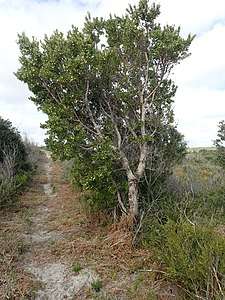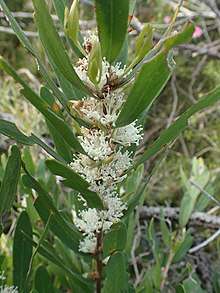Hakea oleifolia
Hakea oleifolia, commonly known as dungyn,[2] or the olive-leaved hakea,[3] is a shrub or tree of the family Proteacea and is endemic to an area along the south coast in the South West and Great Southern regions of Western Australia.[2]

| Dungyn | |
|---|---|
 | |
| Hakea oleifolia growing on the Bibbulmun Track near Walpole | |
| Scientific classification | |
| Kingdom: | Plantae |
| Clade: | Tracheophytes |
| Clade: | Angiosperms |
| Clade: | Eudicots |
| Order: | Proteales |
| Family: | Proteaceae |
| Genus: | Hakea |
| Species: | H. oleifolia |
| Binomial name | |
| Hakea oleifolia | |
 | |
| Occurrence data from AVH | |
Description
Hakea oleifolia is an upright, rounded shrub or tree typically grows to a height of 2 to 10 metres (6.6 to 32.8 ft). It blooms from August to October and produces strong sweetly scented white large flowers on short racemes in leaf axils. Up to 28 showy flowers may appear per raceme. Leaves are elliptic olive-like 3–9 cm (1–4 in) long by 0.5–2.5 cm (0.2–1 in) wide and smooth edged or sparsely toothed. The ovoid fruit are horned woody capsules 2–3 cm (0.8–1 in) long by 1–2 cm (0.4–0.8 in) wide and taper to two prominent horns.[4][5]
Taxonomy and naming
Hakea oleifolia was first formally described by Carl Meisner in 1856 and the description published in Transactions of the Linnean Society.[2][6] Named from the genus Olea- olive and from the Latin folium - a leaf, referring to the resemblance of the leaf to that of the olive tree.[4]
Distribution and habitat
Olive-leaved hakea grows in the wet south-western tip of Western Australia from Busselton to Bremer Bay.[5] An understorey plant growing in woodland and coastal locations withstanding salt-laden winds on clay, sand, loam and gravelly soils. A frost-tolerant species requiring a well-drained site.[4]
Conservation status
Hakea oleifolia is classified as "not threatened" by the Western Australian Government.[2]
 Fruit of H. oleifolia
Fruit of H. oleifolia
References
- "Hakea oleifolia". Australian Plant Census. Retrieved 10 July 2019.
- "Hakea oleifolia". FloraBase. Western Australian Government Department of Parks and Wildlife.
- "Hakea oleifolia". OzNative Plants. Retrieved 27 October 2019.
- Young, J A. Hakeas of Western Australia:A Field and Identification Guide. J A Young. ISBN 0-9585778-2-X.
- Holliday, Ivan. Hakeas:A Field and Garden Guide. Reed New Holland. ISBN 1-877069-14-0.
- "Hakea oleifolia". Biodiversity Heritage Library. Retrieved 27 October 2019.